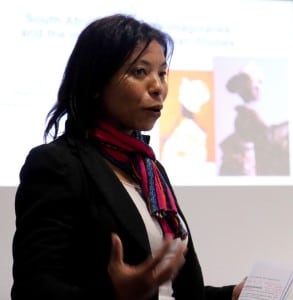“A changing world with growing global connectivity and increased economic penetration between Africa and Asia means we need to increase institutional capacity for more comprehensive scholarly interaction between Asia and Africa.” This was the opinion expressed by Scarlett Cornelissen at the first STIAS seminar of the semester. Cornelissen is professor in the Department of Political Science at Stellenbosch University and a STIAS fellow.

“The current institutional academic infrastructure is deficient to teach emerging scholars in the field,” she continued.
“We need to build bridges between ‘African Asianists’ and ‘Asian Africanists’ and to develop a comprehensive understanding of both the historical and the current nature of the Africa/Asia interface,” she added.
She argued for the need to unpack the methodological and epistemological issues that should underlie a transdisciplinary approach to Asian/African studies particularly in South Africa. “We need to understand what methodological frameworks are appropriate to deal with the complex questions in this field,” she said.
The framework and methodology through which we study has major implications for societal understanding.
“We need to understand how and through which frameworks we study each other,” she said, “and, from the African perspective, really understand what delineating, knowing about and understanding the Asian region means.”
Complex entanglements
“Africa and Asia have a long and complex history. There is evidence that Chinese contact in the region pre-dates European contact,” she said. “There is extensive connectivity and entanglements that have not been fully examined from a scholarly perspective.”
“There is no cohesive body of scholarship,” she added. “Certainly not in a tangible form in the South African context.”
“Most work has been done from specific perspectives – mostly geopolitical – focusing on the big themes and usually serving political agendas which has left many unexplored aspects such as micro narratives and histories.”
Cornelissen briefly discussed some of the ways in which Asia’s relations with Africa have been chronicled to date including histories of the Cape Malays, the slave trade and of Indian involvement in South Africa’s political development. But she pointed to the lack of comprehensive scholarship and the image of Asia as a ‘place of the other’ perpetuated by much of the work.
“There is also an enduring notion of Africa being acted upon by Asia,” she said. “And the current situation which depicts China almost as a neo-colonial force with Chinatowns dotting the urban landscape in Africa enhances this notion.”
“To some extent, ideas of African primitiveness and inferiority still remain. We need self-awareness amongst scholars from both sides to investigate the stereotypes.”
Cornelissen also pointed to the fact that we don’t fully understand the implications of the diaspora of Chinese settlers to Africa. “This has led to increased socio-cultural interaction but these communities have also been frequent targets of xenophobia,” she said.
The reciprocity and the two-way nature of migrancy – with African settler communities in Asian countries has also not been comprehensively explored.
“We have to, in a sense, overcome the myth that surrounds the two continents,” she said. “As well as relooking at the issues based on changing global relationships.”
“Many African elites want to tap into the changing world order and the rise of the East economically,” she said. “I think the interest is beyond mere commodity exchange.”
She, however, pointed to the complexities of such studies. “Language is a major barrier,” she confirmed. “We have to unpack the cultural nuances.”
“Importantly, we also need to understand that there is not one Asia – there are multiple Asias interacting with multiple Africas,” she stressed. “So we need to question ‘which Asia, whose Asia?’ just as we question ‘which Africa, whose Africa?’.”
Michelle Galloway: Part-time media officer at STIAS
Photo: Christoff Pauw
